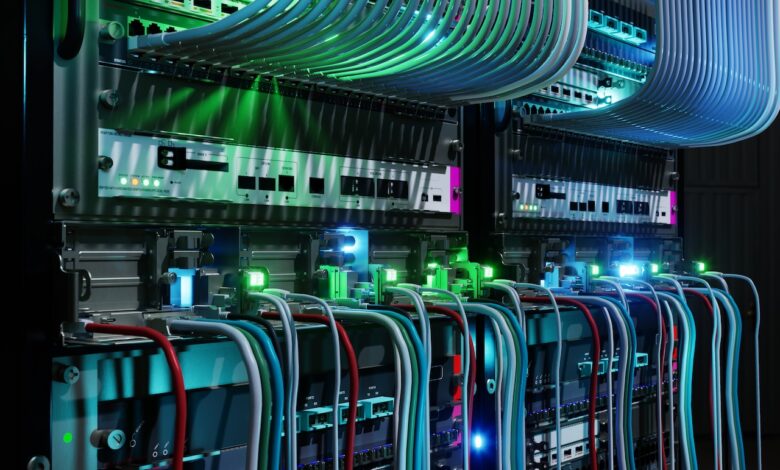
Generating enough power for the demands of artificial intelligence (AI), cryptocurrency and other power-hungry applications, is one of the biggest challenges facing data centres right now. With a power grid already under pressure and in the process of trying to modernise and flex to cope with the huge demands placed on it, the industry needs to rethink the way it adapts to these challenges.
According to figures from the International Energy Agency (IEA), data centres today account for around 1% of global electricity consumption with their annual electricity consumption about half of the electricity consumption from household IT appliances, like computers and phones.
But this is changing with the growth in large hyperscale data centres with power demands of 100 MW or more, and an annual electricity consumption equivalent to the electricity demand from around 350,000 to 400,000 electric vehicles.
Sustainability and growth
With the rise of AI and expectation of what it can deliver, the next few years are likely to see a significant rise in the number and size of data centres, with serious consequences for the energy sector. At the same time, technology firms are under growing pressure to make data centres more energy efficient and sustainable.
Microgrids could be the answer in providing a more sustainable and efficient energy supply for data centres. While the concept of a microgrid can vary depending on how they are used, they can be defined as small-scale, localised electrical grids that can operate independently or in conjunction with the main power grid. They can range in size from a university to a single home.
As a global industry alliance, we’re seeing them used in different scenarios, from residential to large campuses like Apple in the Silicon Valley.
One use case is MCE, a California Community Choice Aggregator, which has established a standardised setup for residential virtual powers plants (VPPs) with OpenADR used as the utility connection to manage the prices and consumption. As a side note, it’s good to see that the MCE project targets low income areas, which often cannot participate in any incentive schemes.
The feasibility and suitability of microgrids depends very much on factors like the specific requirements of the data centre itself, regulatory environment and the long-term goals for sustainability, resilience and cost-efficiency.
In terms of advantages, the real value is in helping overcome grid constraints and improving reliability by managing consumption and maintaining power during grid issues. For data centres that require uninterrupted operation, this ability to deliver resilience is critical.
Sustainability is another key advantage. By integrating renewable energy sources, such as solar or wind power, and energy storage, microgrids can significantly reduce carbon footprint. While in terms of cost savings, they can reduce operational costs by utilising local power generation and demand-response strategies.
Microgrids are modular, which means they can grow as the data centre’s needs evolve. A great example is the Ajax Stadium in Amsterdam (Johan Cruijff ArenA).
Finally, when it comes to regulation, they face fewer regulatory hurdles compared to other options, like nuclear power facilities, because they can operate mostly ‘net zero’ on the grid connection.
What are the challenges?
But for data centre operators and investors trying to address power supply and stability issues, the use of microgrids can also mean challenges.
The first of these is the start-up costs. While we talk about a reduction in operational costs once up and running, set-up costs for microgrids can be high, requiring significant capital investment especially for larger data centres, so important to bear in mind.
Sustainability may be a big plus point, but the use of renewables like solar and wind depend on the weather – and the weather can be fickle. This necessitates robust storage solutions, backup power or large grid connections to ensure reliability and stability at all times.
It’s also important to stress that the effective integration of these various distributed energy sources and systems can be technically challenging, so working with good integrators and partners is paramount.
When it comes to powering data centres, microgrids are not the only option being considered. Alternatives like small modular nuclear reactors (SMRs) are also be touted as potential power sources. In my mind, SMRs are not in competition with microgrids but could become an important baseline component of them.
In their favour, SMRs provide a constant, high-capacity output, ideal for 24/7 operation, and a zero-emissions power source. Once operational, they offer stable costs over decades. But they also face challenges like stringent regulation and public opposition to development, while a nuclear plant, even a small-scale one, involves substantial upfront investment. This is aside from the risks around nuclear waste and safety.
Data centres are going to need a very high continuous supply of power and microgrids offer options for a more resilient and responsive energy infrastructure. Decentralised power through a network of microgrids could help dynamically manage power loads and optimise renewable energy sources – especially as demands on the grid grow as we march onwards towards an AI-powered future.




